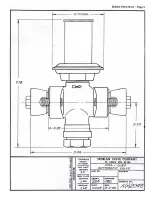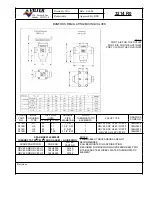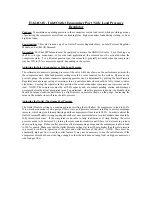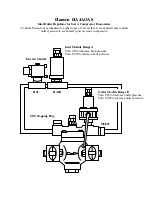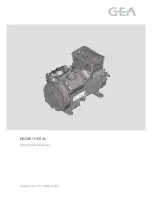
BULLETIN 10-11 /
Page 5
Factors which affect valve performance and may make it necessary
to adjust the valve are:
1.
Low temperature difference (TDs) between the refrigerant and
the air
2.
TEV bulb location
3.
Balance between compressor and evaporator
4.
Ratio of load to TEV capacity
5.
Condenser capacity
6.
Operation of several fixtures on multiple installation
7.
Seasonal variation in head pressure caused by extreme changes in
ambient air temperature.
Note:
Valve Types F, (E)BF/SBF, Q, A, M, V, K, and W have non-
rising adjusting stems and a change in adjustment does not change
the stem position.
When setting valves on multi-evaporator refrigeration systems with
pressure or temperature sensitive evaporator control valves, the
following procedure is recommended:
1.
Evaporator Pressure Regulating Valve (ORI Type): the ORI valve
is set first at the minimum load condition. Then, if necessary, the
expansion valve is adjusted to the desired superheat setting while
under the normal operating load condition.
2.
Temperature Sensitive Evaporator Regulating Valves (CDS
Type): The CDS valve is forced into a fully open position first.
Then the expansion valve is adjusted to the desired superheat
setting at full load condition. Finally, the controller for the CDS
is set to the desired temperature. Contact Sporlan Valve
Company, or the case manufacturer, for additional details on
setting the CDS controller.
When the adjustment is completed on the TEV, always tighten the
adjusting stem packing nut and replace the seal cap tightly.
Many expansion valves are made
non-adjustable
for use on
Original Equipment Manufacturer’s units, particularly those valves
used on residential air conditioning and heat pump systems. These
valves are set at a superheat predetermined by the manufacturer’s
laboratory tests and cannot be adjusted in the field.
Some
non-adjustable
models are modifications of standard
adjustable type valves. This is done by using a solid bottom cap
instead of one equipped with an adjusting stem and seal cap. These
valves can be identified by an
N
preceding the standard valve designa-
tion. Adjustable bottom cap assemblies are available for converting
most non-adjustable valves to the adjustable type. However, this is
rarely required. If symptoms indicate that a valve adjustment is
needed, carefully check the other possible causes of incorrect
superheat, pages 6 through 10, before attempting an adjustment.
How to Determine Superheat
Correctly
1.
Measure the temperature of the suction line at the bulb location.
2.
Obtain the suction pressure that exists in the suction line at the
bulb location by
either
of the following methods:
a.
If the valve is externally equalized, a gauge in the external
equalizer line will indicate the desired pressure directly and
accurately.
b.
Read the gauge pressure at the suction valve of the
compressor. To the pressure add the estimated pressure drop
through the suction line between bulb location and
compressor suction valve. The sum of the gauge reading and
the estimated pressure drop will equal the approximate
suction line pressure at the bulb.
3.
Convert the pressure obtained in
2a
or
2b
above to saturated
evaporator temperature by using a temperature-pressure chart.
4.
Subtract the two temperatures obtained in
1
and
3
– the differ-
ence is superheat.
Figure 8 illustrates a typical example of superheat measurement on
an air conditioning system using Refrigerant 22. The temperature of
the suction line at the bulb location is read at 52°F. The suction
pressure at the compressor is 66 psig and the estimated suction line
pressure drop is 2 psi …66 psig + 2 psig = 68 psig at the bulb, which
is equivalent to a 40°F saturation temperature. (Use dew point
temperature for refrigerant blends.) 40°F subtracted from 52°F =
12°F superheat.
Note:
Refrigerated case manufacturers frequently use a “tempera-
ture difference” method to approximate superheat. This procedure
consists of measuring the temperature of a location on the evaporator
which is representative of saturated vapor temperature; and, then
subtracting that temperature from the outlet evaporator temperature
which is measured at the bulb location.
While this method of reading “superheat” is acceptable on those
manufacturer’s cases where the pressure drop through the evaporator
is low, Sporlan does not recommend the “temperature difference”
method for other types of systems.
How to Change the Superheat
Setting
Note: There are some valve bodies (G, EG, C, S, EBS
and EMC) that have a packing nut around the adjust-
ment stem. It may be necessary to loosen the packing
nut slightly to turn the adjusting stem. Do not forget
to retighten the nut after the superheat is set.
To reduce the superheat, turn the adjusting stem
counter-
clockwise
. To increase the superheat, turn the adjusting stem
clockwise
. When adjusting the valve, make no more than one turn
of the stem at a time and observe the change in superheat closely to
prevent
over-shooting
the desired setting. As much as 30 minutes
may be required for the new balance to take place after an adjust-
ment is made.
What's Your
Superheat?
OBTAIN SUCTION PRESSURE
68 PSIG (at bulb)
Temperature
here reads
52
°
40
°
12
°
SUPERHEAT
Figure 8
Summary of Contents for VSM 71-701
Page 1: ...1 VPN 35391S February 2006 Rev 05 Price 60 00...
Page 2: ...2...
Page 20: ...20...
Page 52: ...53 Pre Start Up Check List...
Page 99: ...99 Recommended Spare Parts List...
Page 104: ...104 Gate Rotor...
Page 110: ...110 Main Rotor VSS...
Page 112: ...112 Main Rotor VSR...
Page 114: ...114 Slide Valve Cross Shafts and End Plate...
Page 118: ...118 Capacity Slide Volume Slide Carriage Assembly Slide Valve Carriage Assembly...
Page 134: ...134 Miscellaneous Frame Components VSS Screw Compressor VSR Mini Screw Compressor...
Page 138: ...138 C FlangeAdapter Components 630 620 610 640 601 641 630 601 620 610 640 641 642 650 651...
Page 140: ...140 Replacement Parts Tools...
Page 144: ...144 GaterotorAssembly...
Page 148: ...148 Main Rotor Slide Valve Cross Shafts and End Plate Models 71 401 Only Counter clockwise...
Page 152: ...152 Main Rotor Slide Valve Cross Shafts and End Plate Model 501 701 Only Clockwise...
Page 154: ...154 Volume Ratio Capacity Slide Carriage Assembly Slide Valve Carriage Assembly...
Page 158: ...158 Miscellaneous Frame Components Model VSM 501 701 Model VSM 71 401...
Page 160: ...160 Replacement Parts Accessories Housing Accessories C Flange Assembly...
Page 166: ...166 Haight Pumps...
Page 170: ...3 Refrigerating Specialties Division...
Page 236: ......
Page 237: ......
Page 238: ......
Page 243: ......
Page 244: ...168...

























